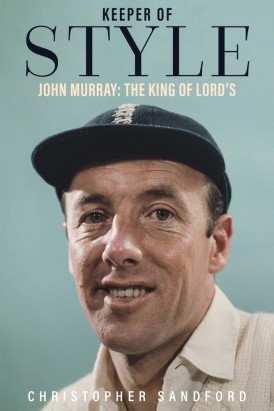Keeper of Style
Martin Chandler |Published: 2019
Pages: 224
Author: Sandford, Christopher
Publisher: Pitch
Rating: 4 stars

In years gone by I have read Christopher Sandford’s biographies of Tom Graveney and Godfrey Evans. I have also read his book on the cricketing casualties of the Great War, and his biography of Imran Khan has spent several years working its way to the top of my ‘pending’ pile without ever quite getting there.
Both the Graveney and the Evans were excellent reads and taught me that Sandford is an accomplished biographer. Why it never occurred to me to investigate the rest of his writing CV I am not sure, but the list that follows the contents page of Keeper of Style sets that out with great clarity. Sandford is clearly a versatile man. I see that he has written lives of Roman Polanski, John F Kennedy , Kurt Cobain, David Bowie and Bruce Springsteen to name but five. All of those individuals are of some interest to me and I may even be persuaded to take a short sabbatical from reading cricket books in order to broaden my horizons.
For 2019 however our great game seems to have been at the top of Sandford’s list of priorities as in addition to this excellent biography of the Middlesex and England wicket keeper, John Murray, he has also published Final Innings, a retrospective on the last pre war summer of 1939. One thing I will do before launching myself at Sandford’s non-cricketing back catalogue is pen a begging letter to the publisher of that one.
As for the late ‘JT’ he was a great personal favourite of Sandford and having had the pleasure, just once, of being introduced to the man himself at Lord’s I can fully understand why. Writing about one’s heroes does not always lead to a balanced book, and I suppose in some ways Keeper of Style is a hagiography, but not in a way that gives any cause for concern, as I certainly don’t recall ever reading or hearing a bad word said about Murray. The book is assisted also by Sandford having been a friend of Murray’s long before he contemplated becoming his biographer.
I remember Murray the cricketer very well from my youth, although I am just too young to have any real memory of him in Tests. He was a bit like Bob Taylor of Derbyshire in that he was a very fine wicketkeeper but, perhaps unfortunately for him, so unspectacular that you almost didn’t realise he was there. Murray was also a batsman good enough to average 22 in Tests and score a memorable century against the West Indies in 1966, but ultimately he was an early victim of selectorial desire to play an all-rounder rather than a specialist.
In the early part of his career Murray found his opportunities limited by Jim Parks of Sussex and then, after finally becoming first choice he soon lost his place to Alan Knott. It must have been frustrating for him to sit in Parks’ shadow, the Sussex man being a markedly inferior wicketkeeper. At least Knotty was Murray’s equal as a stumper.
Sandford is half a generation younger than Murray, but the pair still lived through the same times. As a consequence there are, for those of us a few years younger still who just about remember the swinging sixties but are more certain of our memories of the 1970s and 1980s, some interesting perspectives on the social history of the early sixties. By way of example Sandford presents an admirable summary of the notorious ‘Profumo Affair’ of 1963.
One feature of Sandford’s writing that I particularly enjoyed was the story, weaved into his narrative, of how he got to know Murray. That begins with standard schoolboy hero worship from afar, and slowly develops into a close and enduring friendship. Inevitably in setting out that background there are a number of autobiographical digressions, often on the subject of Sandford’s prep school education. One tale in particular is almost surreal, the story of a young Sandford in Moscow, listening to no less a personality than former Soviet Premier Nikita Khruschev expressing his views on the D’Oliveira Affair.
There is much of interest in Keeper of Style and the book is certainly written in a thoroughly entertaining way. It lacks any sort of statistical appendix although the nature of Murray’s career is such that that is not perhaps so important as sometimes in other cricketing biographies. Sandford would, I have no doubt, defend the omission on the basis that the last thing his book is about is numbers and I think on this occasion I would concede on that one, particularly as there is an excellent index.
Also worthy of mention is the design of the book’s dust jacket, very much of Murray’s time, and the photographic section of the book. I can put my hand on my heart and say this one is as good an example of how that part of a biography should be put together as I have seen and author and publisher both deserve great credit for that. There are a few familiar images but the majority are not and a goodly number originate from the Murray family. Most striking of all is one snap that does not feature Murray at all, but is instead a shot of his England rival Parks walking out to bat with Ted Dexter – I hadn’t realised before just what a powerful athlete ‘Lord Ted’ was in his prime.






Leave a comment